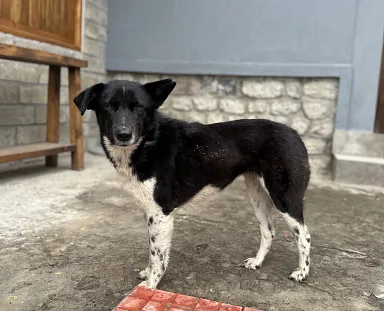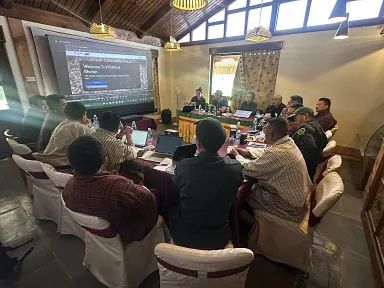
Updates from the Field:
Launching the Bhutan Wild Cat Project
- Author: Courtney Quirin
- Publication Date: July 31, 2025
- Related Project: Bhutan Wild Cat Health Project
- Focus Species: Catopuma temminckii (Asiatic Golden Cat) , Neofelis nebulosa (Clouded Leopard) , Felis chaus (Jungle Cat) , Prionailurus bengalensis (Leopard Cat) , Panthera pardus (Leopard) , Pardofelis marmorata (Marbled Cat) , Otocolobus manul (Pallas’s Cat) , Uncia uncia (Snow Leopard) , Panthera tigris (Tiger)
After 50 hours of traveling, with pit stops in Hong Kong and Bangkok, I arrived in Paro, Bhutan, along with my Felidae coworkers to officially launch the Bhutan Wild Cat Project.
Our schedule was jammed packed: hosting a ranger training for two days in Paro, then setting off to the capital city of Thimphu to meet with our partners, the Bhutan Ecological Society and the Nature Conservation Division of the Bhutanese government.

From there we would embark on a 9-hour drive north to Bhutan’s newest–and largest–national park, Wangchuck Centennial National Park, where we would spend three days traversing forests to set trail cameras along ridgelines and other natural features frequented by wild cats. Our goal in this three-year study is to collect the largest dataset to date on all nine wild cat species, including measuring potential impacts on wild cats by free-roaming domestic dogs and human activities, and quantifying the risk of zoonotic disease transmission.
In order to stave off jet lag and work out the kinks after spending over a day in a plane, I cautiously went for a run in Paro, on the lookout for feral dogs I may encounter.
As a project coordinator and filmmaker for the Bhutan Wild Cat Project, I had done a fair bit of research leading up to the trip, where I learned all about Bhutan’s National Dog Population Management and Rabies Control Project, which is one of the longest-running and most successful sterilization and vaccination programs in Asia.
By the early 2000s, Bhutan’s dog population began to cause human health concerns as rabies spread across a rapidly-growing population of dogs. From 2009 to 2012, the annual number of reported dog bite victims presenting concerns for rabies rose from 1,000 to over 7,000 per year. The Bhutanese government partnered with Humane Society International to launch a catch-neuter-vaccinate-release program in 2009 with the goal of achieving 100% sterilization and 90% vaccination, which it nearly achieved in 2023 after treating over 153,000 dogs.
My initial research into this topic put me a bit on edge and I began to wonder if I should even run while in Bhutan given the risks of encountering a feral dog. But I am an avid runner and needed to shake out my legs after the long trek across the globe, so I ventured out for a four-mile run and, surprisingly, I saw a few horses but not a single feral dog. It seems my research was confirmed: the national dog population management project has successfully reduced dog populations.
However, the national dog population management plan has not studied feral dogs for other deadly diseases, such as the highly contagious parvovirus, which is known to jump from dogs to wild cat species, particularly tigers, leopards, and lions. The Bhutan government is interested in our findings from the project that will create a strategic plan to manage free-roaming dogs in wild cat habitats. The project will also form the first K9 conversation dog unit in Bhutan to conduct fecal surveys across the project study areas in protected areas.
Nomadic, agrarian lifestyles are a cornerstone of Bhutanese culture. Over 60% of Bhutan's population lives in rural areas that overlap with wild cat habitat, including national parks. Rearing dogs to guard crops and livestock is an integral part of nomadic people’s lives. However, many of these dogs are only vaccinated for rabies, and not for other diseases.
Since Bhutan is one of the last havens for endangered and threatened cats, like tigers, snow leopards, and clouded leopards, it is critical to protect these populations so that these species may persist into the future. For example, Bhutan’s protected areas and biological corridors, which cover over 70% of the country, connect tiger populations with habitat in surrounding areas, such as India and Nepal, making Bhutan a tiger source-site and key passageway for maintaining genetically diverse, healthy tiger populations.
After my run, I began to prepare for the next two days of filming: a ranger training workshop and interviews with rangers and project partners.
The rangers traveled from far and wide to attend the training– and I don’t mean that as a tired idiom, but rather as a literal fact. Rangers from the Luana Park Range Office of Jigme Dorji National Park hiked eight days over the Himalayas, crossing glaciers and camping along the way, to reach a road that would take them to Paro for the training. The Luana Park Range Office is the most remote field office in the most remote national park in Bhutan. I learned this during an interview with Yeshi Jamtsho, a ranger from this office, and I asked him to repeat himself to make sure I heard him correctly. In his repeated answer, he told me that he actually hiked extra fast this time and made it in seven days. Now that is commitment to conservation!
I also learned from talking with Dr. Lungten Dorji, one of the Principal Investigators of the project, that by 2070 Bhutan may lose almost 50% of its snow leopard habitat due to climate change. Snow leopards have large home ranges, up to 39 square kilometers (or 9,637 acres or 7,285 football fields), that rely on snow covered peaks often found above 3,000 meters in elevation. Climate models conducted by the Bhutanese government last year found that this niche habitat is quickly disappearing– another reason why the Bhutan Wild Cat Project is urgently needed.
Conducting interviews is one of my favorite parts of being a filmmaker. I love learning about the nuances of people’s lives, like having to walk 8 days to reach a road, and about people’s passions and goals. Yeshi, for example, wanted to be a wildlife biologist as a child, but he didn’t have the means to achieve the level of education needed for the profession, so he sought out being a ranger, which takes him to the front lines of protecting wildlife every day.
After the ranger training we headed to Thimphu for a night, and there, unfortunately, is where my journey ended. I came down with a terrible stomach bug and fever, which took me to the ER twice, and I could not forge ahead with the rest of the team. However, I lived vicariously through them, and biologist Ben Cohen stood in as team filmmaker and photographer.
Since we returned home from our trip in early May, nearly all of the 120 trail cameras have been deployed across our four study areas. Rangers will deploy an additional 280 cameras later this year, and conduct fecal surveys across the study areas to measure any pathogens commonly carried by dogs.
We are launching our social media campaign for this project later this year, where you can experience the action, meet some of the rangers spearheading the research, and learn how this project will help Bhutan’s wild cats thrive into the future.
Follow our journey on Instagram and YouTube @felidaefund
Do You Have 2-4 Hours A Month To Preserve Your Local Ecosystem?
Our volunteers are the driving force behind making true change in ecosystem health and wild cat conservation. Some like to volunteer in the field, others help us maintain our online presence, and some work with events. With just a few hours a month, you can make a difference, too.
Make A Difference Right Now
As a 501(c)3 nonprofit, our work is only possible because of generous donors like you.
More than 90% of your donation will go directly to our groundbreaking research, outreach, and education programs.
This is where true change starts. If you’d like to be a part of it, make a donation to Felidae Conservation Fund today:
Or,
